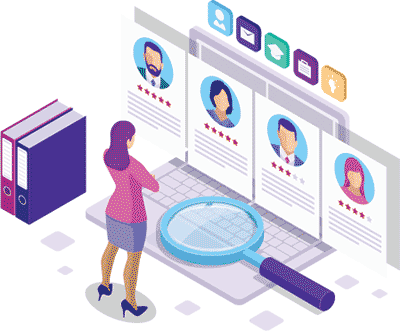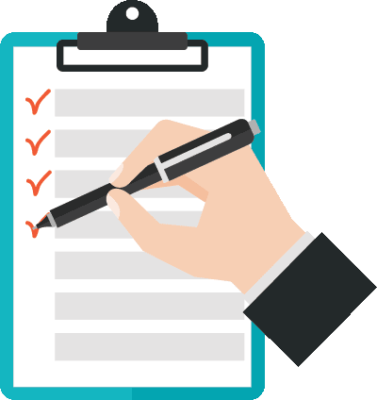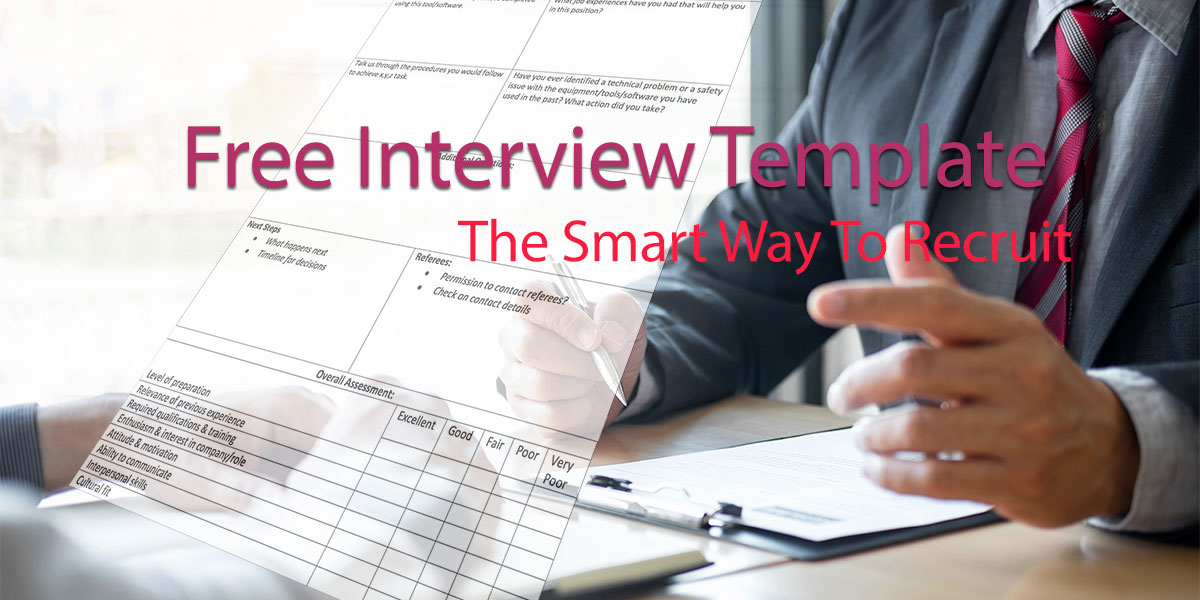How many of us have been involved in an interview process where there has been some disagreement amongst panel members and an inability to reach a consensus on the best candidate? This is a common problem that has its roots in poor preparation and an inconsistent process. To be successful, interviews have to be well-structured and follow the same consistent format so that everyone is on a level playing field. The interview template is the way to ensure you achieve just that.
Love it or hate it, for the majority of employers, the interview is still the preferred assessment tool for recruiting and hiring new staff members. There’s something about the opportunity to interact face-to-face with a candidate, question them about their responses to likely workplace scenarios and assess their experience based on examples of how they dealt with issues in the past. Other recruitment tools such as aptitude tests or skills assessments may be an important part of the process, but because they are impersonal are unlikely to be the sole means of assessing potential new recruits. After all, a candidate may have a great test result but simply not fit in with the culture and setup of your company.
In this post, we take you through the steps required to develop an effective interview template that can be easily adapted for any recruitment process. In addition, we provide a model interview template that you can download and use in your organization or modify to suit your own requirements.
Interview Template: Be Prepared
 The key to a successful interview process is being prepared. An interview template helps to ensure you’ve thought of everything in advance so that on the day, the interviews run smoothly and with all members of the panel fully briefed and working in tandem. Before you can develop the interview template, some preparatory work is required. What is the job you are recruiting for? And what are the main responsibilities and success criteria? Working your way through the following steps will ensure you have all the information to hand when developing the interview template.
The key to a successful interview process is being prepared. An interview template helps to ensure you’ve thought of everything in advance so that on the day, the interviews run smoothly and with all members of the panel fully briefed and working in tandem. Before you can develop the interview template, some preparatory work is required. What is the job you are recruiting for? And what are the main responsibilities and success criteria? Working your way through the following steps will ensure you have all the information to hand when developing the interview template.
What Is The Role You Are Recruiting For?
Sounds obvious, but the starting point has to be the job, so be clear from the get-go about all the basic information, including the following:
- job title
- the department the person will belong to
- details of their line manager and any direct reports
- responsibilities of the role – a complete job description isn’t necessary here, what’s required is a summary of the general responsibilities and key tasks so that you are clear about what the role involves and how it aligns with the business’s overall objectives. You can then develop interview questions that will elicit whether the candidate has the necessary skills.
What Are The Key Indicators Of Success?
Once you have established the basic requirements of the role, it’s time to consider the success criteria. This is essential so that you are able to assess how well the jobholder is doing. Try asking the following questions:
- What will the jobholder need to do in their first year in the job?
- What will they need to accomplish in their first three months to demonstrate they are on track?
How Will You Evaluate The Candidate’s Skills?
Once you’ve established what skills the postholder requires, it’s time to consider how you will evaluate them. It’s important to distinguish between qualifications, skills and personality traits.
Qualifications involve formal study such as degrees, diplomas and certificates, which may be a requirement of the job. An electrician, for instance, needs to have a formal qualification as a minimum in order to do the job. Skills refer to clearly defined abilities. A teacher, for example, needs lesson planning skills, and an architect would most likely require skills in computer-aided design software. Finally, there are the softer skills or personality traits that are necessary for the job. These often include the ability to work as part of a team, self-management skills as well as being an excellent communicator in terms of speaking, writing and listening.
 So, what are the key criteria for the job in hand? Draw up a list and try to keep it as concise as possible as it’s these criteria that you will be seeking to assess in the interview. Concentrating on the must-haves rather than also trying to cover the optional nice to haves will help to focus your attention on what’s really important.
So, what are the key criteria for the job in hand? Draw up a list and try to keep it as concise as possible as it’s these criteria that you will be seeking to assess in the interview. Concentrating on the must-haves rather than also trying to cover the optional nice to haves will help to focus your attention on what’s really important.
Some of the skills you’ve identified can be assessed through an aptitude test or by taking up references from previous employers. It may also be possible to craft a test with, say, a sample campaign or project that is similar to one the candidate will encounter in the role. The test can be completed in advance or as part of the interview and is designed to give the candidate a taste of what’s involved in the job and also gives the interview panel the opportunity to assess their work.
However, most skills will be assessed in the interview setting with a series of questions. Based on each major task and responsibility, the questions should reflect the knowledge, skills and abilities required for the position. The old adage that the best predictor of future behavior is past behavior has a lot of truth in it, and so the best questions to ask are those that are behavior-based. Try including some problem-solving questions or workplace scenarios that encourage the candidate to think creatively. And opt for more open questions rather than closed ones that could result in just a yes or no response. It’s essential that all candidates are asked the same set of questions. That way, you will be treating everyone equally and you will also be comparing like with like.
Developing An Interview Template
Having completed all the preparatory work, it’s now time to press on with developing the template itself. To save time, if you have a company intranet solution like MyHub, you might consider setting up a form to collect the interview information or alternatively utilize an embedded Google Form. Embedding your interview template directly on a business intranet page allows you to convey important contextual information such as explanatory notes alongside the form. What’s more, it’s possible to restrict access and editing rights to the form by employing a set of rules so that only interview panel members can view and amend the interview template. All updates take place in real-time and so panel members can be confident that the interview template on the intranet is the very latest version – there’s no need to trawl through a series of emails trying to locate the most recent updates.
As well as helping to ensure a consistent framework, the interview template will also assist with time management. The average interview is typically only 60 minutes long and there’s a lot to get through. The interview template will keep panel members focused on the task.
What Information Should Be Included In The Interview Template?
The interview template will vary depending on the role and its specific requirements. There are, however, a number of elements that are common across any recruitment process and which need to feature in your interview template. These include the following:
Basic Information
Start off with the basics of name, role, and interview panel members.
 Agenda
Agenda
Outline the format of the interview, introduce the panel members and give the candidate the opportunity to talk about themselves in general terms to help put them at ease.
Resume Review
Next is a review of the candidate’s resume. Use this as an opportunity to clarify any queries or obtain extra information on past roles.
Behavioral Questions
This is the most important part of the interview and includes your problem-solving questions and workplace scenarios. In the model interview template, we have included a number of standard questions around such areas as teamwork, leadership and decision-making abilities. These are designed to be used in any interview situation and will also guide you on developing more specific questions directly relating to the role.
Additional Questions
Often the candidate has their own questions and it is useful to keep a brief record of those or any other issues that arise within the interview.
Referees
It’s worthwhile to double-check the details of the candidate’s referees.
Next Steps
The interview should conclude with an outline of the next steps in the process for the candidate and the time frames involved.
Overall Assessment
Once the interview is completed, each panel member should complete an overall assessment of the candidate’s performance. It’s best to do this straight away while your memory is still fresh.
Free Interview Template
Here is a free interview template that you can download and use or adapt to your own requirements. Also included is a set of behavioral questions in key areas that are common across a range of job positions. In addition, there are some sample job-specific questions to get you started.

This template is also available for download in the following formats:
PDF Document: Interview Template.pdf
Microsoft Word: Interview Template.docx
Interview Template For A Smoother, More Successful Process
The average cost of recruiting, hiring and training a new staff member has been estimated to be in the region of $4,000 per new recruit and that’s before wages or salaries are factored in. Get it wrong, and the costs to your business in terms of low productivity, absenteeism, employee disengagement and high turnover can very quickly inflate this figure to a significant amount. With so much invested in a successful recruitment outcome, including the time and involvement of the interview panel members, it’s vital that companies streamline the process and make it as efficient as possible.
Developing an interview template can help your business to do just that. It also means that you will be conducting a fair, transparent and documented interview process should you subsequently be challenged about the decisions made and the selection procedure involved.
Use the model interview template here to kick-start the process and ensure smoother, more successful recruitment outcomes for your business.
For more information on developing interview templates, then get in touch with the expert team at MyHub. Our cloud-based, pre-built intranet solutions can support effective recruitment practices in your company while delivering a whole host of other business benefits. Contact us for a free demo or 14-day no-obligation trial.







0 Comments